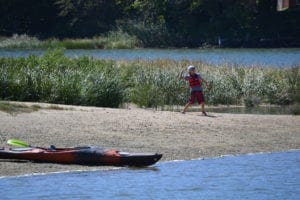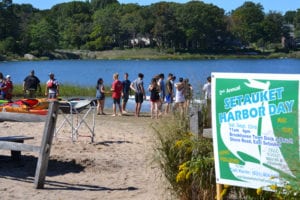By Alex Petroski
Cooperation between members of government, especially from differing political parties, is a scarce natural resource these days, but don’t tell that to leaders from Brookhaven Town, Suffolk County and New York State. Setauket Harbor and the surrounding area is set to be the beneficiary of that cooperation, as leaders from each of the three municipalities formed an agreement Sept. 23 aiming to protect the historic and natural resources of the harbor.
“The Parties are committed to conserving, improving, protecting and interpreting Setauket Harbor’s historic and natural resources and environment through preservation of historic sties, wildlife areas and viewsheds to enable appropriate uses of harbor resources,” the agreement read in part. It also stated that preventing, abating and controlling water, land and air pollution will be a part of enhancing the health and safety of the people who live within or visit the Setauket Harbor Watershed.
The agreement is a Memorandum of Understanding, meaning it is not law, but rather a set of guiding principles or a moral commitment to follow in the years ahead.

The cosigners of the document, Brookhaven Town Supervisor Ed Romaine (R) and Councilwoman Valerie Cartright (D-Port Jefferson Station); Suffolk County Leg. Kara Hahn (D-Setauket); state Assemblyman Steve Englebright (D-Setauket); and representatives from the Department of Environmental Conservation and Setauket Harbor Task Force left the agreement open-ended in the hopes that other branches of government and organizations will follow suit. The Setauket Harbor Task Force, a three-year-old community organization dedicated to improving water quality and the marine habitat in the harbor, spearheaded the agreement after finding local levels of government share a common interest in protecting and improving the harbor, though they were working concurrently rather than coordinately in some ways.
The memorandum was signed on a town dock off Shore Road in Setauket as part of the third Setauket Harbor Day, an annual event established by the task force in 2015.
The first mission laid out by the document is to develop a natural and cultural resource inventory of the harbor, which will be a springboard toward creating a management plan designed to achieve the preservation goals of Setauket Harbor and the roughly three-square miles surrounding it, known as the watershed, by acquiring lands within it, preserving historic sites, sharing ideas, engaging in open, ongoing discussions and contributing funds.
“You need to have a starting point and a vision for how all these pieces come together, and I think that’s what’s so great about this designation,” said George Hoffman, co-founder of the Setauket Harbor Task Force.
Englebright credited the task force with getting everyone involved and focused on the problems associated with Setauket Harbor, which among others include nitrogen pollution and the presence of coliform bacteria, mostly due to storm water runoff into waterways. The harbor falls within the larger Port Jefferson Harbor Complex, which lets out into the Long Island Sound.
In Sept. 2016, state Sen. John Flanagan (R-East Northport) announced he had secured a $1 million grant from the state to be used on enhancing the quality of the harbor’s waters, and the town dock on Shore Road. Englebright thanked Flanagan for his leadership in bringing issues regarding the harbor to light, but a recent annual study completed by Stony Brook University School of Marine and Atmospheric Sciences still shows the body of water is an area of concern.
“Some of the parcels we’re trying to protect are very vulnerable,” Englebright said. He added although the agreement is only an understanding and not law, he hopes that will change in the future. “What I’m hoping we can do within the context of a completed plan is that we can revisit that question at the state legislative level and write something that may have broad applicability. I think this whole plan has the potential to be a model.”
Romaine said he was excited for the possible benefits to the environment the agreement could bring, but also for the potential economic benefit of a healthier harbor.

“The Harbor has been closed to shell fishing for more than 10 years,” he said. “We’d like to see it open up. We’d like to see some of the contaminants eliminated from this harbor so that it can restore itself. It’s very important to the town. I want to thank Steve because he’s done tremendous work, and we’ve worked together as colleagues for more than 35 years.”
Hahn suggested homes in the watershed could be prime candidates for Suffolk County’s Septic Improvement Program, an initiative that offers funds to homeowners within the county to replace outdated cesspools and septic system, which are major contributors to nitrogen pollution in waterways.
The federal government is not currently on board as part of the agreement, though DEC Regional Director Carrie Meek Gallagher said she expects that to change once a plan is in motion. The significance of the collaboration across party lines and municipality lines in lockstep with a community group like the task force was not lost on Cartright.
“This should be a prime example of how government on all levels should work together with the community,” she said.
Kevin McAllister, the founder of the nonprofit Defend H20, said while the agreement is a positive step, it will be largely symbolic if it is not followed up with action, and more importantly, funding.
“Providing greater funding for a host of projects, land acquisition, more protective zoning, denying shoreline hardening permits — these type actions, individually and collectively will define the resolve as put forth in the MOU,” he said in an email.
Englebright implored members of the public and community groups to not only get on board, but to take the additional step of holding elected officials to the terms of the agreement, including those who come after the incumbent lawmakers.





